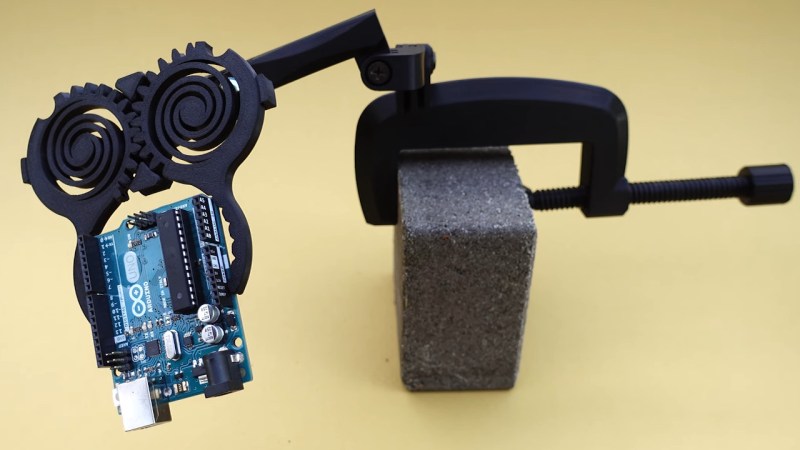We probably don’t have to promote the benefits of a third hand or PCB holders in general, such is their obvious utility. While you can arrange some boxes and pile up tools on your bench to get a similar result, a good grip and flexibility to move the PCB around during soldering or performing any other work on it makes life just so much easier. Thanks to 3D printing there have been plenty of inspiring designs that go beyond the usual clumsy-yet-cheap croc clip version of it, and [SunShine] adds one on to the list with his spring-loaded print-in-place PCB gripper, demonstrated in this video and available on Thingiverse.
The gripping part’s design is based on a spring-loaded box [SunShine] created a little while back — which you can read more about in his Instructable. The holder itself comes in two varieties: one that brings its own stand, and one that has a GoPro mount. The first one is really more to show off the design, and while the gripping part is fully functional, it might not perform too well with heavier boards and easily tip over. Sure, a bigger bottom or mounting it to something more sturdy will fix that, but so will the GoPro-mount version, which also adds the whole flexibility aspect.
If you do prefer something standing more sturdily on your desk though, have a look at the concrete-mounted solder squid from earlier this year. And if you’re interested in more of [SunShine]’s work, check out his 3D-printed brush collection.
















Pretty clever little design. Ever since I got my 3d printer, I promised myself I’d never download and print other people’s models more than 10% of the time and focus on building my own CAD and slicing for the other 90%. It’s worked out well so far. 3d printers become gimmicks and toys when people just use them to churn out plastic trinkets and baubles and other bric-a-brac nonsense from thingiverse and never use it to realize their own imagination or mechanical designs. But sometimes there is stuff on thingiverse which is not trash, and that makes the 10%. I think this’ll be one of them.
Working with the vertical additive nature of the parts has really stimulated my lateral thinking and creativity and ingenuity I think, at least in this narrow field. It’s brilliant to be able to think with the way parts rise off the bed and get mechanical components to form in place without supports, create dynamic structures and springs and such. And to make those tolerances just right. It has been a great exercise in humility too lol. Have some respect for the people who designed everything around you, especially those you never notice or take for granted—those were the hardest things to get right!
You must be a riot at parties…
Maybe do yourself a favor and head on over to thingiverse to see if someone has designed a claw to remove the stick from your rear.
Great design!
*1 for soundtrack snippet from Cowboy Bebop.
Very cool design.
I don’t understand why people want to use “3rd hands” for soldering, though. I just put the boards flat on my desk. Or hold things BigClive style.
And that works as long as the board has a flat side too. When I design my over-packed PCBs, with different components with different heights on both sides, I either use a foam (which melts), or a 3rd hand.
I always add some M3 mounting holes in the corners, and then screw in some hex spacers to keep the board level and sturdy. If I need access to both sides, I put spacers on top too, but this is fairly rare.
That’s a very good idea..
Like Daniel below says, being able to rest my wrist on the desk is very important when dealing with tiny components. Having the board floating in the air means I have to raise my hands, which makes it very hard to keep them still.
It’s even worse when working under a microscope, because the 3rd hand amplifies vibration, and if the board is not level, you constantly have to refocus when you move around.
I’d be worried that the PCB falls down as soon as I touch it with the soldering iron.
At work we have a cheap (most of it is plastic) vise with a ball joint. It has no problems holding really big PCBs. The only thing I don’t like about it is that the work piece is too high to rest your arm on your wrist during soldering.
I use a all metal version from proxxon. The ball is actually a almost round ball, so positioning is quite smooth. They are really cheap for what you get.
I use a whole pack of Blu-Tack rolled into 2 or 3 balls. Height correct, holds any wires in position I am about to solder and can rest my wrists on the table.
Nice design, looks cute, reminds me of an insect, but it’s not practical at all.
Does not clamp a PCB well eoungh to do any kind of work, like probing or soldering. There might be a use case for a spring loaded clamp with low gripping force somewhere in the lab, but holding your PCB to work on it needs to a mechanism that is way more solid than this.
This is a neat design. It is fun to see the evolution of the parts involved…all of the individual components were used/tested on previous random designs (clocks, extruder gears, gear toys, etc) but in this design they are all combined for an all in one printed thing that is more useful than aesthetic.
I have a Panavise with dual mounts (can’t recommend it enough) so I don’t think I will use this for holding PCBs too often but I am going to print one to keep around the shop…you never know where it will be useful.